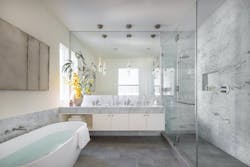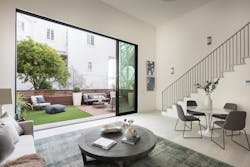Feng shui can and should be incorporated as soon as possible, from the choice of site to the orientation of the building down to the floor plans and furnishings. It's all about creating a harmonized home that is going to bring joy, love, and peace to whoever is in that space.
Here are five ways to use feng shui in a remodel:
Courtesy Ennate
Use the floor plan layout to bring balance to a home
To have a well-balanced home, you don't want to have any cramped, narrow hallways or large empty areas where you're going to feel really exposed and vulnerable. So feng shui can help you control the flow of traffic so that you've got a nice, even flow of energy. If you think about the traffic in your home being like water, you want it gently dispersed throughout the home rather than a full-on flood—which would be an empty room with not enough furniture in it. And you don't want it really cramped into a tiny little trickle—a tiny hallway with a lot of furniture that you have to squeeze through. One way that pros can open up a cramped space very easily is through mirrors. Mirrors will help bring in light and air. There are also so many amazing designs out there that are also decorative. I like to put big mirrors in small bathrooms or in hallways to open up the space and bounce light.
Designate spaces even in an open concept remodel
I love an open concept home, and it’s not that hard to create some kind of designation. For an open-concept layout, I would balance it through furnishings and floor plans, so even if you have an open concept space and there isn't a wall, you can designate areas like with the furnishings and nooks. When you look at it, you still feel like there's a separation, yet you still have all of the light and air throughout the space. You could put up a bookcase or some plants. They're really easy ways of just creating some separation without having things completely blocked off.
Courtesy Ennate
Paint light colors on top, dark colors on the bottom
When choosing paint colors, I always go with dark colors on the bottom lighter colors up top, whether or not that's in terms of the furnishings or the paint on the walls. This combination of darker on the bottom and lighter on the top really helps you to feel grounded: It’s like you have earth at the bottom and heaven up top. If you're ever in a room that perhaps has dark walls and a dark ceiling with light floors, you'll feel a little disoriented--less stable. If you pay attention to how you feel, it's almost like you're disappearing into the floor. This doesn't have to mean you must make a huge change like black floors and white walls. It could be the slightest difference in shade, but that can really make a difference in a person's well-being.
Courtesy Ennate
Use nature as inspiration
Feng shui is that it's all about nature and animal instinct. I look at a lot of animals, how they behave, and the sites that they choose to live in. For example, when they go to sleep, they're going to choose a soft cozy nest-like area. They're not going to plop themselves down in the middle of a white, cold room where they're totally exposed. So if that's the way that they are choosing to sleep and feel protected, isn't that how we would also feel? Sometimes we get out of touch with our primal needs. It looks so cool to have an empty white bedroom with almost nothing in it, but in reality, it doesn't really make you feel that safe or very zen.
Keep bedrooms soothing and neutral
Similarly, I always try to avoid bright colors in the bedroom because they're very stimulating. I love color, but in a bedroom, the priority is to rest and to sleep. You don't want to stimulate yourself with bright colors. I think that's a big sort of mistake that a lot of parents make in children's bedrooms: They make them really bright with a lot of toys. That's really awesome for a playroom, but if they want their child to feel more rested, I would recommend having more muted colors or something more natural.




